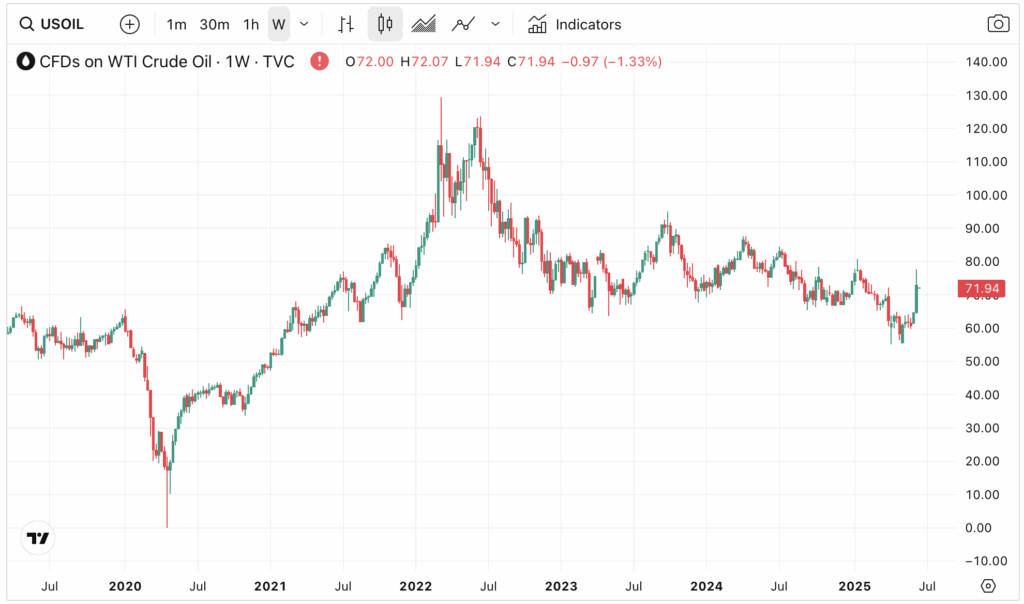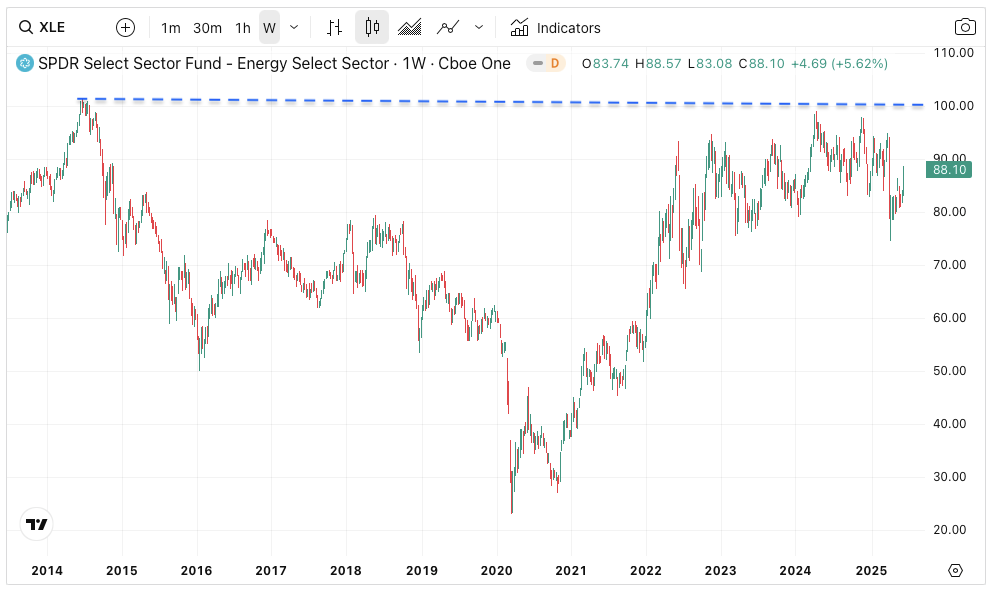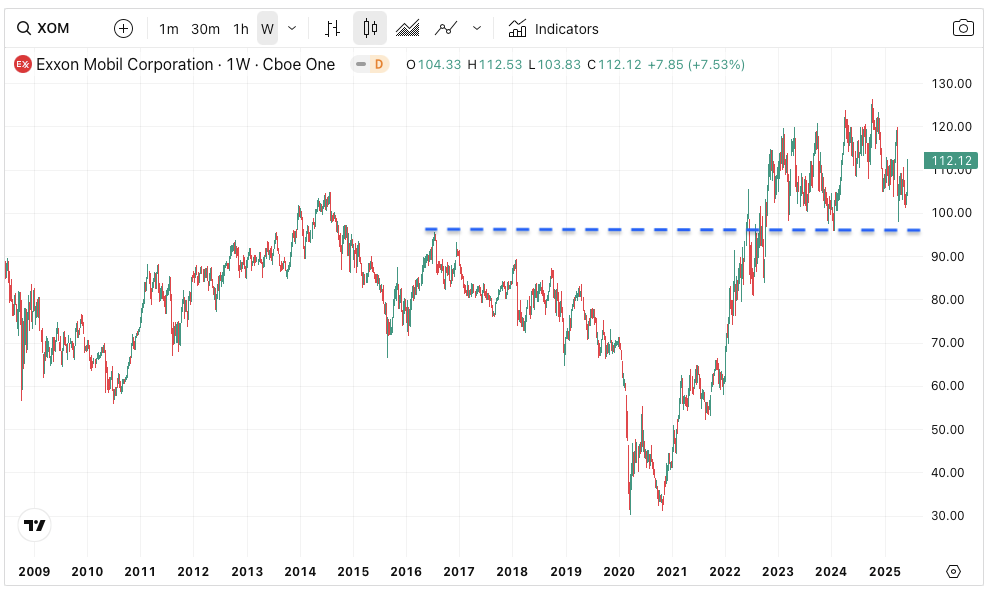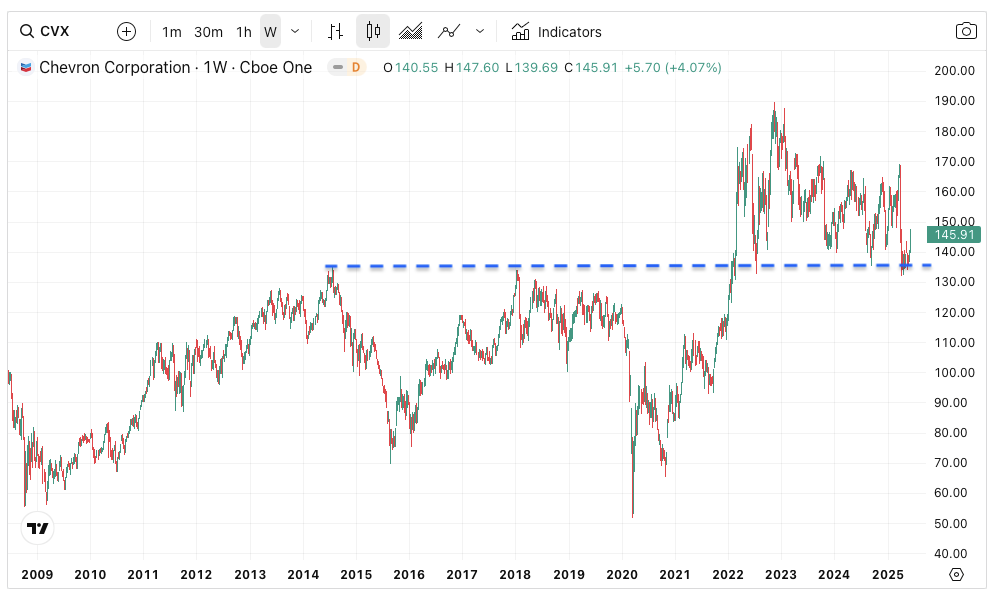To invest in oil stocks, you need a stockbroker like eToro or Hargreaves Lansdown, where you can buy oil companies like Exxon, Chevron, Shell and BP. You can also invest in oil through an ETF like the WisdomTree WTI Crude Oil, which you can buy on interactive investor. In this guide we will look at the best oil stocks to buy and if they are good investments.
Escalating Military Conflicts in the Middle East Boost Oil Prices
A new front in the Middle East is being wedged wide open. This time, Israel and Iran are shooting deadly missiles at each other. The war is real. Casualties are mounting; facilities are flattened.
The growing conflict is the latest military chapter in the region, following the Israel-Hamas battle. Implications of this nightly exchange of deadly projectiles will ripple for years to come. But, the US stock market appeared calm last week. No major hiccups noted (yet).
Beneath the smooth surface, some sectors are responding. The first area to analyse is obviously the oil market.
Whenever war breaks out in the Middle East, oil prices shoot up. Why? Because the region is one of the largest producers of hydrocarbons. Iran alone is estimated to produce more than 1 million barrels of oil per day. On Monday morning, oil prices are back in the $70-80 per barrel range.

Is the escalating conflict between Iran and Israel enough to permanently reverse oil’s bearish posture?
Just a month ago, the oil market was mired in deepening negativity, a sentiment captured by IEA’s Monthly Report (a must-read for energy analysts).
For example, in the May report IEA noted:
Oil prices resumed their downward trajectory in late April and early May as trade tensions impacted financial and commodity markets and OPEC+ agreed to a further unwinding of production cuts…….Signs of a slowdown in global oil demand growth may already be emerging and will be tracked closely……With the rises in global supply expected to considerably outpace demand growth, oil inventories are forecast to jump an average of 720 kb/d this year
In other words, the energy market was set for a determined slowdown due to deteriorating global demand. OECD recently issued a similar outlook (3 June), noting that the “global outlook is becoming increasingly challenging. Substantial increases in trade barriers, tighter financial conditions, weakened business and consumer confidence, and elevated policy uncertainty all pose significant risks to growth.“
Unless the current conflict eliminates oil supply faster than demand, thus creating an oil deficit, there is no sustained bull run to be had here. Occasional oil price spikes due to a temporary surge of fear may happen. These sudden rallies, however, could easily deflate just as fast. Before you know it, prices may resume the downward trend.
Moreover, the two warring parties may be forced, for whatever reason, to sit down and make a deal. It is not sure yet if both countries are eyeing to start a long-term conflict. If this happens, oil trends may reverse their recent advance.
Lastly, high oil prices would be detrimental to the global economy. Oil demand, already stretched due to tariffs, would be crushed, thus sending oil prices tumbling.
Should you invest in oil stocks?
Based on the above discussion, should you still invest in the oil sector?
The oil equity sector is showing some signs of life after the latest jump in oil prices. The key, however, is sustainability. I think many investors are probably waiting to see further bullish confirmations before buying oil stocks.
Trendwise, the sector appears static. Look at the popular US SPDR Energy Sector ETF (ticker XLE), an ETF with $28 billion AUM.
While the ETF rallied hard during 2021-2022, its upward momentum has completely stalled at the resistance level at 100, a resistance dating back to 2014. For the past two years, XLE was locked in between $75-100. Oil spikes may send XLE into the region $90-100 but unless an upside breakout materialises, this sideways pattern may continue for the time being.
This is the general trend of oil stocks. What about individual stocks?
The top three stocks in XLE – Exxon Mobil (US:EOM), Chevron (CVX) and ConocoPhillips (COP) – occupy 46.7 per cent of the Fund. We take a look at the top two stocks below, in addition to BP and Shell listed in the LSE:

Exxom Mobil (US:XOM)
Exxon Mobil is by far the largest oil company in the world, with a market cap approaching $500 billion ($483 bn to be exact). Its dividend yield of 3.5 percent is by no means generous, but it is still an excellent level to buy in.
Pricewise, XOM is trading north of the psychological $100 for some years. This is a positive factor as it suggests opportunistic and continuous buying at this level. Even with oil prices at $60-70, Exxon managed to earn $7.7 billion in the last quarter.

Chevron Corporation (US:CVX)
Chevron is the second largest oil company in America, with a market cap of $254 billion. Compared to XOM, CVX’s price chart appears much more volatile. It peaked in late 2022 near $190 and corrected to near $130 recently. This is a drawdown in excess of -31 percent.
Note that prices were smashed down from $170 recently. This sharp downside volatility may turn off investors. But the stock’s dividend yield of 4.7 percent appears attractive and may help to stabilise the stock somewhat. Support is already noted at the former peak ($130).

Shell (LSE:SHEL)
Shell is one of the largest oil stocks in Europe, worth more than £150 billion based on 13th June closing price. Trendwise, the stock is trading within a nice range; 3,000p to the upside and 2,200p to the lows (see below).
Prices recently broke above the long-term trendline (150-day MA), indicating a potential rally into the March highs at 2,800p. Shell’s dividend yield of 4.1 percent attracts investors with sticky hands. If oil prices can sustain its rebound, Shell may reach 3,000p.
BP (LSE:BP.)
BP is the smaller competitor to Shell. Its market cap is just a little above £60 billion. Perhaps its growth prospect is inferior to that of Shell’s. Unsurprisingly, BP has been trading lower in a series of zig-zag moves.
In April for example, its price trend suffered some technical damage when prices dumped to three-year lows (330p). Because risk appears higher here, BP’s dividend yield is more generous – 6.3 percent. This is more than two full percentage above Shell’s. Whether these dividends are sufficient to compensate for the potential capital loss in holding BP shares is uncertain.


Jackson is a core part of the editorial team at GoodMoneyGuide.com.
With over 15 years of industry experience as a financial analyst, he brings a wealth of knowledge and expertise to our content and readers.
Previously, Jackson was the director of Stockcube Research as Head of Investors Intelligence. This pivotal role involved providing market timing advice and research to some of the world’s largest institutions and hedge funds.
Jackson brings a huge amount of expertise in areas as diverse as global macroeconomic investment strategy, statistical backtesting, asset allocation, and cross-asset research.
Jackson has a PhD in Finance from Durham University and has authored over 200 guides for GoodMoneyGuide.com.
To contact Jackson, please ask a question in our financial discussion forum.


